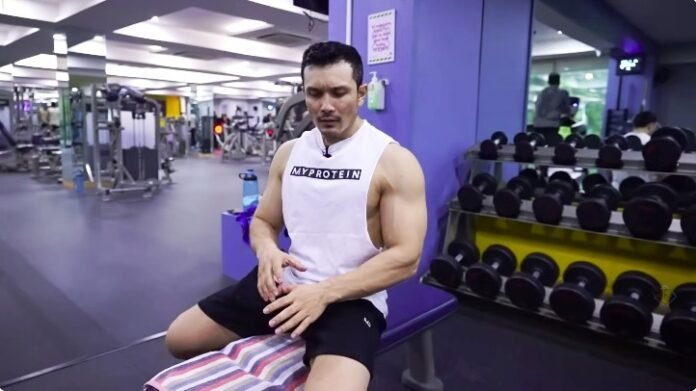
You’re midway through your heaviest set of bench press or curls when you feel it—a sharp twinge or a deep, nagging ache in your elbow. The rest of your workout is overshadowed by that pain, and you’re left wondering if you should just “push through it” or panic and schedule a doctor’s appointment.
First, know this: you are not alone. Elbow pain from weight lifting—often called Lifter’s Elbow—is one of the most common complaints in the gym. The good news is that it’s often not serious and is almost always fixable with the right knowledge. This guide cuts through the confusion, giving you an experienced lifter’s perspective on how to understand, treat, and permanently prevent this frustrating setback.
Table of Contents
What Exactly Is This Pain? Diagnosing “Lifter’s Elbow”
Before you can fix it, you need to identify it. The vague term “elbow pain” usually points to one of two specific types of tendonitis. Forget the complex medical jargon for a moment; let’s break this down in practical terms.
- Medial Epicondylitis (Golfer’s Elbow): Do you feel pain on the inner side of your elbow, especially when gripping or during pulling movements? This is your culprit. Despite the name “Golfer’s Elbow,” it’s rampant in weight rooms. It involves the tendons of your forearm flexors—the muscles that let you grip the bar and curl your wrist.
- Common Culprit Exercises: Bicep curls, rows, chin-ups, and any movement involving a tight, repetitive grip.
- Lateral Epicondylitis (Tennis Elbow): Is the pain on the outer side of your elbow, flaring up during pushing movements? This is Tennis Elbow from lifting. It affects the tendons of your forearm extensors.
- Common Culprit Exercises: Bench press, overhead press, tricep extensions, and push-ups.
A Quick Self-Check:
- Press on the bony bump on the inside of your elbow. If it’s tender, it’s likely Golfer’s Elbow.
- Press on the bony bump on the outside. If that’s tender, it’s likely Tennis Elbow.
A Critical Note: This information is for common, exercise-related pain. If you experience severe, unrelenting pain, numbness, tingling that travels down your arm, or significant swelling, stop immediately and consult a medical professional. This guide is for rehabilitation, not replacement of a formal diagnosis.
The Real Reasons Yo get Elbow Pain From Weight Lifting (It’s Not Just “Lifting Weights”)
As an experienced lifter, I can tell you that elbow tendonitis from weightlifting is rarely a mystery. It’s almost always a consequence of one or more of these specific, correctable mistakes. Understanding the “why” is the first step to a permanent solution.
- Ego Lifting: This is the #1 cause. Loading the bar with weight you can’t control with perfect form is a direct ticket to Tendon Town. Your muscles might handle it, but your connective tissues (tendons and ligaments) cannot, leading to inflammation and micro-tears.
- Poor Pressing Form: Flaring your elbows out at a 90-degree angle during a bench press places immense shear stress on the elbow joint. This is a primary driver of tennis elbow from lifting.
- Poor Pulling & Curling Form: Using momentum to swing heavy dumbbells or curl a barbell shifts the stress from the target muscle directly to the elbow tendons. A tight, “death grip” on the bar also exacerbates Golfer’s Elbow from lifting.
- Muscle Imbalances: Many lifters have relatively weak forearms, triceps, and rotator cuff muscles compared to their prime movers like the chest and biceps. These weaker stabilizers fail, and the elbow joint takes the punishment.
- Neglecting Your Warm-Up: Jumping straight into your heavy working sets is like revving a cold engine to redline. Your tendons are stiff, blood flow is low, and they are completely unprepared for the stress you’re about to impose.
Fix It Now: Your Immediate Game Plan for Relief
When pain strikes, your immediate reaction determines how long your recovery will be. The goal is to control inflammation and stop re-aggravating the tissue.
Step 1: Follow the RICE Protocol (The First 48-72 Hours)
- Rest: This is non-negotiable. You must take a break from the exercises that cause pain. This doesn’t mean complete inactivity, but it does mean avoiding direct aggravation.
- Ice: Apply an ice pack to the painful area for 15-20 minutes, several times a day. This helps reduce inflammation and numbs the pain.
- Compression: A simple weightlifting elbow brace (a counter-force strap) can be helpful. Worn just below the painful spot, it helps offload the tendon by redirecting force through the brace itself.
- Elevation: Keep the arm elevated when possible to help reduce swelling.
Step 2: The Strategic Deload
“Rest” doesn’t have to mean sitting on the couch. A “deload week” is a powerful tool. For the next 1-2 weeks:
- Reduce the weight on all upper body exercises by 50-60%.
- Focus exclusively on flawless, pain-free form.
- If an exercise hurts, even with light weight, skip it entirely for now.
Step 3: Smart Pain Management
Over-the-counter anti-inflammatories (like Ibuprofen) can help manage pain and inflammation in the short term. However, view them as a temporary bridge, not a solution. The real fix comes from the rehab and prevention strategies in the next steps.
The Rehab Zone: Your Blueprint to Fix Elbow Pain from Lifting
You’ve identified the type of Lifter’s Elbow you’re dealing with and you’ve taken the critical first steps to calm the inflammation. Now comes the most important phase: active rehabilitation. This is the part most articles and lifters gloss over, but it’s the absolute key to a permanent solution. True recovery isn’t passive; it’s about strategically rebuilding the tendons and muscles so they can handle the demands you place on them.
Think of this not as a setback, but as an opportunity to build bulletproof elbows. The exercises below are your tools to fix elbow pain from lifting for good.
Rehab Exercises for Lifter’s Elbow (The Foundation of a Pain-Free Future)
The goal here is controlled, deliberate effort to stimulate blood flow and promote tendon remodeling. We will focus on two key areas: restoring flexibility and, most critically, performing eccentric strengthening, which is the gold standard for tendon rehab.
A. The Essential Stretches (Daily Mobility for Relief)
- Forearm Flexor Stretch (Targets Golfer’s Elbow)
- Extend your sore arm straight out, palm facing up.
- Gently pull your fingers and palm downward until you feel a stretch along the inner forearm.
- Why it works: This directly addresses the tight forearm flexors that are pulling on the medial epicondyle.
- Hold for 30-45 seconds. Repeat 3 times per day.
- Forearm Extensor Stretch (Targets Tennis Elbow)
- Extend your sore arm straight out, palm facing down.
- Gently press the back of your hand downward until you feel a stretch along the outer forearm.
- Why it works: This loosens the tight extensors that are the root of lateral epicondylitis from lifting.
- Hold for 30-45 seconds. Repeat 3 times per day.
B. The Critical Strengthening Phase (Eccentric Focus is Key)
Eccentric exercises (the slow lowering phase) are proven to be the most effective method for healing tendons. They build strong, resilient tissue. Start with no weight or a very light dumbbell (2.5-5 lbs).
- Eccentric Wrist Flexions (For Golfer’s Elbow Rehab)
- Rest your forearm on a table, palm up, wrist off the edge.
- Use your healthy hand to lift the weight into a flexed position.
- Remove the helping hand and take a full 3-5 seconds to lower the weight back down. This slow descent is what drives the healing.
- Perform 3 sets of 12-15 slow repetitions.
- Eccentric Wrist Extensions (For Tennis Elbow Rehab)
- Same setup, but with your palm facing down.
- Assist the weight up, then slowly lower it over 3-5 seconds.
- This directly targets the weakened tendons causing elbow pain after exercises like bench press.
- Perform 3 sets of 12-15 slow repetitions.
- The Tyler Twist (Using a FlexBar for Maximum Effect)
- If you want the most effective tool for how to treat elbow tendonitis, a FlexBar is it. Research backs its high success rate.
- For Tennis Elbow: Hold the FlexBar vertically, twist it into a “U,” and place both hands on the grips. Slowly allow the bar to untwist by resisting with your top (injured) hand.
- Perform 3 sets of 15 repetitions.
C. Strategic Strength Re-introduction (Pain-Free Movement Patterns)
As pain subsides, carefully bring back compound movements using tendon-friendly variations.
Hammer Curls & Neutral Grip Work: The neutral grip (palms-facing) is far kinder on the elbow tendons than a supinated grip. Make this your go-to for bicep and rowing movements during your recovery. This grip not only minimizes strain on the brachioradialis and common flexor tendons but also keeps the wrist in a stable, joint-friendly alignment. Over time, consistent use of neutral-grip variations can help maintain arm strength while giving the irritated tendons a chance to heal. You can apply this approach to hammer curls, neutral-grip pull-ups, and dumbbell rows for a safer, pain-free way to train the upper arms and back.
Rope Pushdowns: Using a rope attachment for tricep work allows your wrists to find a neutral, pain-free position, reducing stress on the elbow joint. This adaptability lets each arm move along its natural path, preventing overextension or torque that straight-bar attachments often cause. Additionally, the rope variation emphasizes the triceps’ lateral and long heads more evenly, supporting balanced arm development. By focusing on controlled movements and a full extension at the bottom, you’ll stimulate the muscle effectively while protecting the tendons—an ideal strategy during recovery or for long-term joint health.
The Rehab Golden Rule: If you feel a sharp, shooting pain during any exercise, STOP. A deep ache or discomfort is normal, but sharp pain is a signal to regress or pause. This is about healing, not heroism.
You now have the blueprint to actively rehabilitate your elbows and rebuild them stronger than before.
Lift Smart, Not Hard: How to Prevent Elbow Pain Forever
You’ve diagnosed the issue, and you’re actively rehabbing your tendons. Now, let’s ensure you never have to go through this again. The final step is about integrating intelligent, proactive strategies into your training philosophy. Prevention isn’t a single action; it’s a series of smart habits that protect your joints from the wear and tear of heavy lifting.
This is where we move from being just a lifter to being an athlete who respects the mechanics of their own body.
Master Your Form: The Most Powerful Prevention Tool
Poor technique is the engine of overuse injuries. Fine-tuning your form is the single most effective way to prevent elbow pain when lifting. Let’s break down the critical cues for the most common culprits.
For Pressing Movements (Bench Press, Overhead Press):
- The Cue: “Tuck Your Elbows.” Instead of flaring your elbows out at a 90-degree angle (a major cause of tennis elbow), keep them at a 45-60 degree angle from your body. This places the shoulder in a safer position and drastically reduces the shear force on the elbow joint.
- The Cue: “Break the Bar.” As you bench, imagine trying to bend the bar in half towards your feet. This external rotation of the shoulders automatically engages your lats and creates a more stable, elbow-friendly pressing platform.
- Avoid Hyperextension: Don’t “lock out” with a violent snap at the top of your press. Push to a strong, straight arm position without jamming the joint.
For Pulling and Curling Movements (Rows, Pull-ups, Curls):
- The Cue: “Avoid The Death Grip.” You don’t need to squeeze the bar with all your might. A firm, secure grip is sufficient. White-knuckling the bar needlessly fatigues the forearm flexors, contributing to golfer’s elbow.
- Control the Eccentric: The lowering phase of a curl or row is just as important as the lift. Don’t let gravity win; control the weight down. This builds the very tendon resilience we focused on in Step 2.
- Use Straps for Heavy Pulls: If your goal is to build your back and not necessarily your grip strength, don’t let a failing grip compromise your elbow health. Using straps on heavy deadlifts and rows allows you to move the weight without over-stressing your forearms.
The Non-Negotiable Warm-Up Protocol
Walking into the gym and jumping straight into your working sets is a recipe for injury. Your tendons are like leather; they need to be warmed up to become pliable and resilient.
Your 5-Minute Upper Body Warm-Up:
- Cardio Burst (2-3 minutes): Jump rope, rower, or bike to increase core body temperature and blood flow.
- Dynamic Stretching (1-2 minutes):
- Arm Circles (forward and backward)
- Cross-Body Arm Swings
- Scapular Wall Slides (excellent for shoulder and upper back activation)
- Specific Activation (1-2 minutes):
- Band Pull-Aparts (2 sets of 15-20) to activate the rear delts and upper back.
- Light Face Pulls with a band (2 sets of 15) to prime the rotator cuff.
Programming for Longevity
Your workout plan itself can be your best defense or your worst enemy.
- Balance Your Volume: Ensure your pushing and pulling volume is relatively balanced. An overdeveloped chest and front delts paired with a weak back create postural imbalances that stress the shoulders and elbows.
- Incorporate Deloads: Every 6-8 weeks, schedule a deload week where you reduce your training volume and intensity by 40-60%. This gives your joints, tendons, and nervous system a chance to recover fully and supercompensate.
- Embrace Variation: Regularly rotate your exercises. Switch from a barbell bench press to dumbbells. Swap a straight-bar curl for hammer curls. Changing the stimulus prevents any single tendon from being overloaded in the exact same way repetitively.
Gear & Supports: What Actually Works?
Let’s be clear: gear is a tool, not a solution. It should augment good form, not replace it.
- Elbow Sleeves: For Warmth and Proprioception.
- What they do: Elbow sleeves for lifting increase blood flow to the joint, keep the tendons warm, and provide a slight compressive feel that can enhance proprioception (your sense of where your joint is in space).
- When to use them: For your heavier working sets, especially on pressing movements. They are a fantastic preventative tool.
- Counter-Force Braces: For Pain Management.
- What they do: A weightlifting elbow brace (the strap you see on tennis players) works by applying pressure to the tendon below the painful site, which can slightly offload the force placed on the tendon attachment during contraction.
- When to use them: Primarily during your rehab phase or if you feel a nagging ache returning. It’s a temporary aid, not a permanent fixture.
Conclusion: Your Path to Pain-Free Lifting
Elbow pain from weight lifting is a signal, not a life sentence. It’s your body’s way of telling you that something in your training—be it your form, your volume, or your recovery—is out of balance.
You now have the complete guide, from understanding the anatomy of Lifter’s Elbow to executing the precise rehabilitation exercises that heal, all the way to implementing the strategic prevention tactics that will keep you in the game for the long run.
The journey to pain-free lifting starts with patience and discipline. Start with the rehab exercises today. The next time you step into the gym, approach the bar with intention and respect for your body’s mechanics. Your future self—with strong, healthy, and resilient elbows—will thank you for it.
Read Also: Foot Health Protocol in Basketball: Injury Prevention and Recovery



